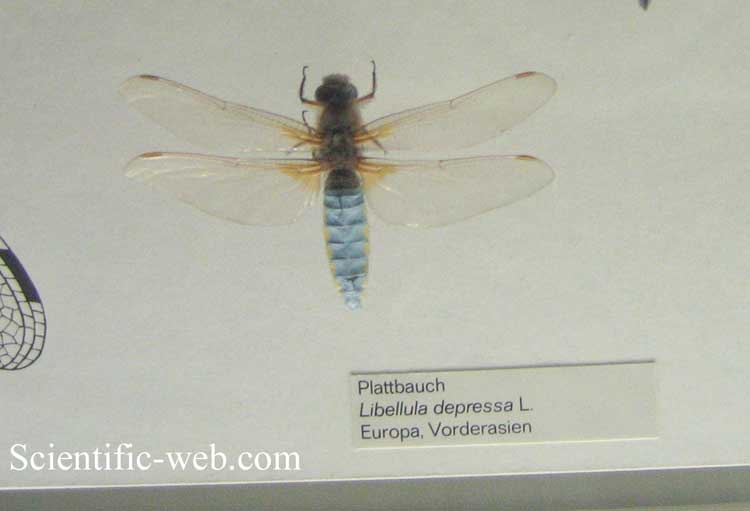
Libellula depressa
Superregnum: Eukaryota
Cladus: Unikonta
Cladus: Opisthokonta
Cladus: Holozoa
Regnum: Animalia
Subregnum: Eumetazoa
Cladus: Bilateria
Cladus: Nephrozoa
Cladus: Protostomia
Cladus: Ecdysozoa
Cladus: Panarthropoda
Phylum: Arthropoda
Subphylum: Hexapoda
Classis: Insecta
Cladus: Dicondylia
Subclassis: Pterygota
Cladus: Metapterygota
Cladus: Odonatoptera
Cladus: Holodonata
Ordo: Odonata
Subordo: Epiprocta
Infraordo: Anisoptera
Superfamilia: Libelluloidea
Familia: Libellulidae
Subfamilia: Libellulinae
Genus: Libellula
Species: Libellula depressa
Name
Libellula depressa Linnaeus, 1758
Vernacular names
български: Плоскотело живениче
čeština: Vážka ploská
Cymraeg: Picellwr praff
Deutsch: Plattbauch
English: Broad-bodied chaser, Broad bodied chaser
suomi: Litteähukankorento, Litteähukankorento
français: Libellule déprimée, Libellule déprimée
മലയാളം: ബ്രോഡ് ബോഡീഡ് ചെയ്സർ
Nederlands: Platbuik, Platbuik
norsk nynorsk: Brei blålibelle
norsk: Bred blålibelle
livvinkarjala: Läčäkköhukankorendo
polski: Ważka płaskobrzucha
русский: Стрекоза плоская
Türkçe: Geniş cüsseli yusufçuk
中文: 基斑蜻
Libellula depressa, the broad-bodied chaser or broad-bodied darter,[1] is one of the most common dragonflies in Europe and central Asia. It is very distinctive with a very broad flattened abdomen, four wing patches and, in the male, the abdomen becomes pruinose blue.
Identification
The male and female have a broad, flattened abdomen which is brown with yellow patches down the sides. In the male the abdomen develops a blue pruinosity that covers the brown colour. Both fore and hind wings have a dark patch at the base. Both the male and female have broad antehumeral stripes. The average wingspan is approximately 70 mm. L. depressa is very distinctive and should not be confused with any other dragonflies in the region.
Variation in juveniles and adults
Male L. depressa showing flat, broad abdomen with blue pruinosity
Juvenile male
Female L. depressa showing dark wing bases and yellow spots on the abdomen
Old female L. depressa is much darker than the young female
Broad-bodied Chaser, maturing male, South of France
Broad-bodied Chaser, adult female, South of France
Hunting and returning to a favoured perch
Distribution and habitat
L. depressa is found in central and southern Europe, central Asia and the Middle East. It range extends northwards to southern Scotland, southern Sweden and southern Finland and it occurs on some Mediterranean islands including Corsica, Sardinia, Sicily, and Menorca. Its range does not extend beyond southern Europe into Africa.
L. depressa is seen near still-water lakes and ponds, feeding on many types of small insects. They occur in both bare and sunny locations, where it is often the first dragonfly to colonise new habitats such as newly created ponds, and well vegetated ponds. L. depressa are often seen away from water as the adults are very mobile and undergo a period of maturation away from water after emergence. The adults are also migratory.
Behaviour
The flight period is from April to September but are mostly seen in May and June. Their flight is very fast as they dart and dive above the water. They are very territorial and will fight with rival males and any other dragonflies they happen to encounter. They characteristically return to a favoured perch, in the sun. When a female enters a male's territory the male will fly up and grab the female. Mating occurs on the wing and the pair are in tandem for only a brief period, often less than a minute. The pair separate and the female will find a suitable location for ovipositing, usually a stretch of open water with submerged vegetation. The female oviposits in flight, hovering above the water and dipping the tip of her abdomen in. The eggs hatch in 4 or 5 weeks and the larvae take one to two years to develop. The larvae live in the silt and detritus at the bottom of the pond, lying buried in mud with just the head and eyes showing. After emergence the adults move away from water and undergo a period of maturation which lasts 10 to 14 days.
Ovipositing
South of France
young adult female Farmoor Reservoir, UK
Emergence of the imago
Nymph
Newly emerged adult
Systematics
This species is usually placed in the genus Libellula but there is some evidence, based on RNA and DNA analysis, that this species should be placed within the genus Ladona (Artiss et al., 2001). This change is not yet generally accepted and books and field guides list this species as Libellula
See also
Libellula
Libellulidae
List of British dragonflies
References
Hart. M., et al, (1978), The Naturetrail Omnibus, London: Usborne Publishing Limited, page 157
"Broad-bodied Chaser". British Dragonfly Society.
Thomas Artiss; Ted R. Schultz; Dan A. Polhemus; Chris Simon (2001). "Molecular phylogenetic analysis of the dragonfly genera Libellula, Ladona, and Plathemis (Odonata: Libellulidae) based on mitochondrial cytochrome oxidase I and 16S rRNA sequence data" (PDF). Molecular Phylogenetics and Evolution. 18 (3): 348–361. doi:10.1006/mpev.2000.0867. PMID 11277629. Archived from the original (PDF) on 2007-09-29.
Askew, R. R. (2004) The Dragonflies of Europe. (revised ed.) Harley Books. ISBN 0-946589-75-5
Boudot J. P., et al. (2009) Atlas of the Odonata of the Mediterranean and North Africa. Libellula Supplement 9 :1–256.
d'Aguilar, J., Dommanget, J. L., and Prechac, R. (1986) A field guide to the Dragonflies of Britain, Europe and North Africa. Collins. pp336. ISBN 0-00-219436-8
Dijkstra, K.-D. B & Lewington, R. (2006) Field Guide to the Dragonflies of Britain and Europe. British Wildlife Publishing. ISBN 0-9531399-4-8
Retrieved from "http://en.wikipedia.org/"
All text is available under the terms of the GNU Free Documentation License

